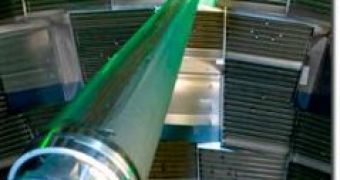Scheduled to start the preliminary experiments in 2008, the technicians at the National Ignition Facility, or NIF for short, double the pace to finalize the installation of the rest of the 192 lasers as the construction completion date is only a year and a half away.
Out of the 144 beamlines that are used by NIF to initiate the laser pulses, only 96 of them have been used together for the first time to verify the control system and laser stability. When completed, the total energy radiated by the lasers in the form of infrared light would exceed 1.8 million Joules, concentrated in the center of a firing chamber, in a pulse lasting only 10 nanoseconds, equivalent to about 1,000 times the energy consumed by the United States in the same amount of time.
So far the lasers from NIF have emitted more than 2.5 megajoules of energy, about 40 times more than the previous experiment, the Nova laser, which was at the time the biggest laser in the world. Due to the fact the laser fusion experiment require the minimizing of the energy loss, the infrared radiation emitted by the laser, needs to be converted to ultraviolet before it is being sent towards the firing chamber. During the laser test during the end of July this year, each of the 96 beams of lasers were able to output a energy of about 22,000 Joules, greatly outperforming the basic requirements for the NIF's experiment.
The NIF has as primary objective the exploration of inertial confinement fusion and the exploration of high-energy high-density physics and nuclear weapons for the United States. The basic principle of the inertial confinement fusion consists in firing laser beams towards a target represented by a plastic sphere containing a few milligrams of fusion fuel, which is typically a mix of tritium and deuterium, two of the isotopes of hydrogen. As the lasers burn through the plastic capsule, it is rapidly turned into a plasma and blown outwards. At the same time, the principle of action and reaction creates a shock wave which further heats and compresses the fusion fuel, and when the show wave meets itself in the middle of the burning fusion fuel it compacts it into an incredibly small volume, to trigger a chain nuclear fusion reaction.
The laser system shoots beams of infrared light that lasts for about 25 billionths of a second, with the help of 2,300 high-quality optics operated by about 400 computers processing about a million lines of program codes every second controlling the system. Even though the time and spacial dimensions of the fired laser beam are extremely short, the energy output and the frequencies are designed to vary in significant ranger throughout the duration of the experiments, depending on their types.
According to Chris Haynam, only a dozen people actually participated in the control room during NIF's overnight 'owl' shift, to make possible the completion of commissioned activities for the laser bay, as most of the physicists and engineers in charge with the execution of the plan on schedule, worked all the necessary details long before they were put into execution.
During 2003-2004 experiments conducted on powerful computer simulation, the NIF team successfully showed how high energy levels correlated with high quality beams were required to produce the first demonstration of an inertial confinement fusion reaction. Also LLNL's supercomputers have been able to match the actual experimental data that indicate that the laser beams would propagate effectively through the plasma targets to produce the fusion ignition and chain fusion reaction burn.
These kinds of plasmas can only be found in exploding thermonuclear weapons, the cores of stars and giant planets and could reveal key information about the nature and structure of the universe.
NIF's next goal is to conceive a series of experiments, scheduled to take place next year, in which the 96 laser beams would be fired on a fusion fuel target.

 14 DAY TRIAL //
14 DAY TRIAL //